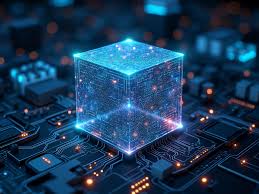Introduction

Programmable matter is a transformative concept that envisions materials capable of changing their properties, shape, and function based on external instructions or inputs. By merging advanced computing with material science, programmable matter can adapt to meet specific needs in real-time, offering unprecedented levels of flexibility in how objects are used, manufactured, or interacted with. This futuristic material could drastically change industries ranging from manufacturing to healthcare, leading to new, more efficient ways of creating and utilizing materials.
The idea behind programmable matter involves creating materials that can alter their physical state, size, shape, or even electrical and thermal properties at will. These materials are typically composed of small, modular components (often referred to as “motes” or “modules”) that can communicate with each other and respond to external stimuli, such as magnetic fields, light, heat, or electrical signals.

Key mechanisms involved include:
- Modular Design:
Programmable matter often relies on a modular approach, where tiny units of matter (think of them like small, self-contained “building blocks”) are capable of reconfiguring themselves into different shapes or structures. These modules can move, join, or separate in response to specific commands or environmental changes. - External Control:
Through the application of specific commands, such as electrical signals, light, or even magnetic fields, external devices or systems can dictate the behavior of the material. These systems orchestrate how the modules reassemble, alter their properties, or even combine to form new materials with distinct capabilities. - Smart Interactions:
Through sensing technology, programmable matter can “sense” its environment and make decisions about how to act. For example, it could detect changes in pressure, temperature, or even chemical compositions, and adjust its form or function accordingly. This allows for highly adaptive behaviors, such as a self-healing material that could respond to damage by reassembling its structure.
How It Works
Potential Benefits
- Incredible Versatility:
Programmable matter can be customized to suit specific needs, whether for use in construction, healthcare, or consumer products. For instance, a material could be programmed to transform from a soft, flexible material into a hard, rigid structure as needed, allowing a single object to serve multiple purposes. - Minimized Waste:
Because programmable matter can change its form or repurpose itself as needed, it could reduce the need for waste in manufacturing processes. Instead of producing a new item from scratch, material components could be rearranged or reconfigured, leading to more sustainable production methods. - Self-Repairing Systems:
Programmable materials could feature self-repairing properties, where the material detects damage and autonomously heals itself. This could lead to longer-lasting products in industries such as construction or electronics, minimizing maintenance costs and increasing product lifespan. - Customization and Adaptability:
In fields like medicine or fashion, programmable matter could be used to create custom items on demand. For example, surgical implants that adjust to fit a patient’s unique body or clothing that adapts to a person’s size and shape on the fly could become a reality. - Enhanced Robotics and Automation:
Programmable matter could play a major role in robotics, particularly in the development of soft robotics or reconfigurable robots. Robots with the ability to reshape themselves to adapt to different tasks could revolutionize industries such as logistics, space exploration, or medical surgery.
Why It’s Underrated
Despite its immense potential, programmable matter remains an underrated innovation due to the following factors:

- Technological Limitations:
The technology required to build programmable matter is still in its infancy. Developing materials with the necessary properties and the ability to reconfigure in a controlled manner is an extremely challenging task. The materials need to be lightweight, durable, and able to switch between different forms without sacrificing strength or performance. - Complexity of Control Systems:
The control systems that direct programmable matter must be sophisticated enough to handle the dynamic nature of reconfiguring materials. Designing reliable, scalable, and efficient control mechanisms that can guide millions or even billions of modular units requires advanced algorithms and computing power. - High Cost of Research and Development:
Developing programmable matter involves significant investment in both time and resources. Research into nanotechnology, robotics, and material science is costly, and funding for such high-tech projects can be difficult to secure. This has slowed the widespread development of programmable matter systems. - Ethical and Regulatory Concerns:
The idea of materials that can change their shape and form raises potential concerns around misuse, particularly in military or surveillance applications. There are also questions regarding how these technologies might impact traditional industries or lead to job displacement in areas like manufacturing.
Challenges Ahead
- Scalability:
While early prototypes of programmable matter may work on a small scale, scaling these technologies to create materials that can be used in real-world applications remains a significant challenge. The infrastructure needed to manufacture, control, and deploy programmable matter on a large scale has yet to be fully developed. - Material Stability:
One of the major hurdles is ensuring that programmable materials remain stable and retain their desired properties when transitioning between forms. Maintaining strength, flexibility, or other necessary features during reconfiguration is vital for ensuring the material is reliable and safe for use in critical applications. - Energy Efficiency:
The process of changing material shapes or properties often requires external energy. Ensuring that programmable matter systems are energy-efficient enough for practical use—without consuming excessive amounts of power or creating waste heat—is a challenge for designers. - Interdisciplinary Collaboration:
Programmable matter sits at the intersection of multiple scientific disciplines, including materials science, robotics, nanotechnology, and computer science. Successful development will require highly coordinated efforts among researchers in these fields, which can be difficult to achieve and requires significant collaboration.

Conclusion
Programmable matter is a groundbreaking innovation that promises to revolutionize industries and everyday life by providing materials that can change their shape, function, and properties on demand. From self-healing materials and adaptive structures to customizable products and robots, the possibilities are vast. However, significant technological, financial, and regulatory challenges still need to be overcome before programmable matter becomes a practical reality. While the development of programmable matter may take several more years to fully realize, its potential for reshaping manufacturing, healthcare, construction, and many other sectors makes it one of the most exciting innovations of the future.
